Organizational Analysis of Nestle: Structure, Tension, and Operations
VerifiedAdded on 2020/03/28
|10
|2859
|121
Report
AI Summary
This report provides a detailed organizational analysis of Nestle, examining its adoption of a bureaucratic organizational structure to manage its global operations. It explores the company's internal structure, including centralization and formalization, and how these elements contribute to its success. The report highlights Nestle's short-term and long-term goals, emphasizing its strategies to maintain market leadership and expand its customer base. Furthermore, the analysis delves into the challenges of managing structural tensions, particularly the coordination between management and employees and differentiation in interpersonal styles. The report concludes by outlining the strategies Nestle employs to mitigate these tensions, such as encouraging coordination, establishing clear communication channels, and resolving conflicts to ensure efficient operations across its international units. The report underscores the importance of these strategies for Nestle's continued growth and success in the competitive food industry.
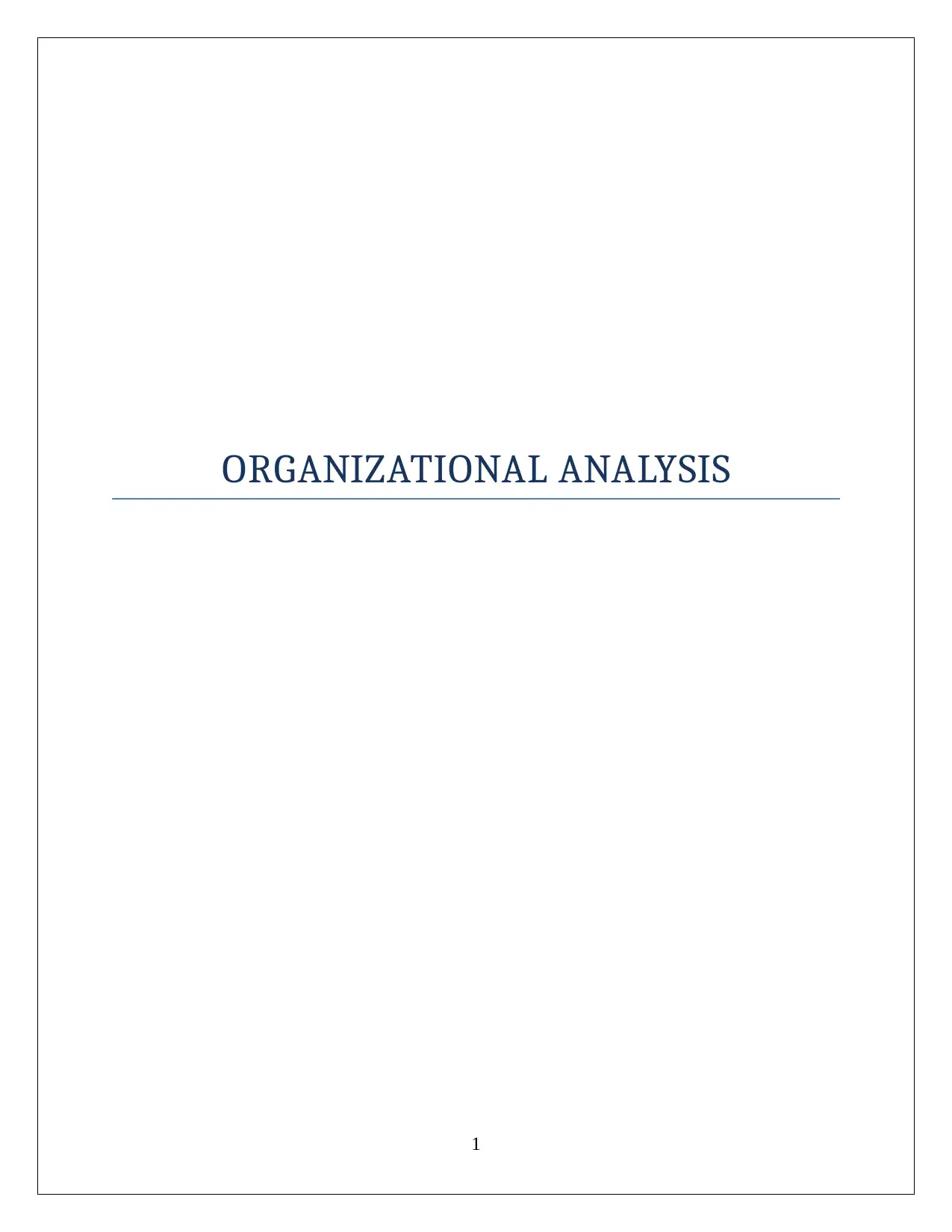
ORGANIZATIONAL ANALYSIS
1
1
Paraphrase This Document
Need a fresh take? Get an instant paraphrase of this document with our AI Paraphraser
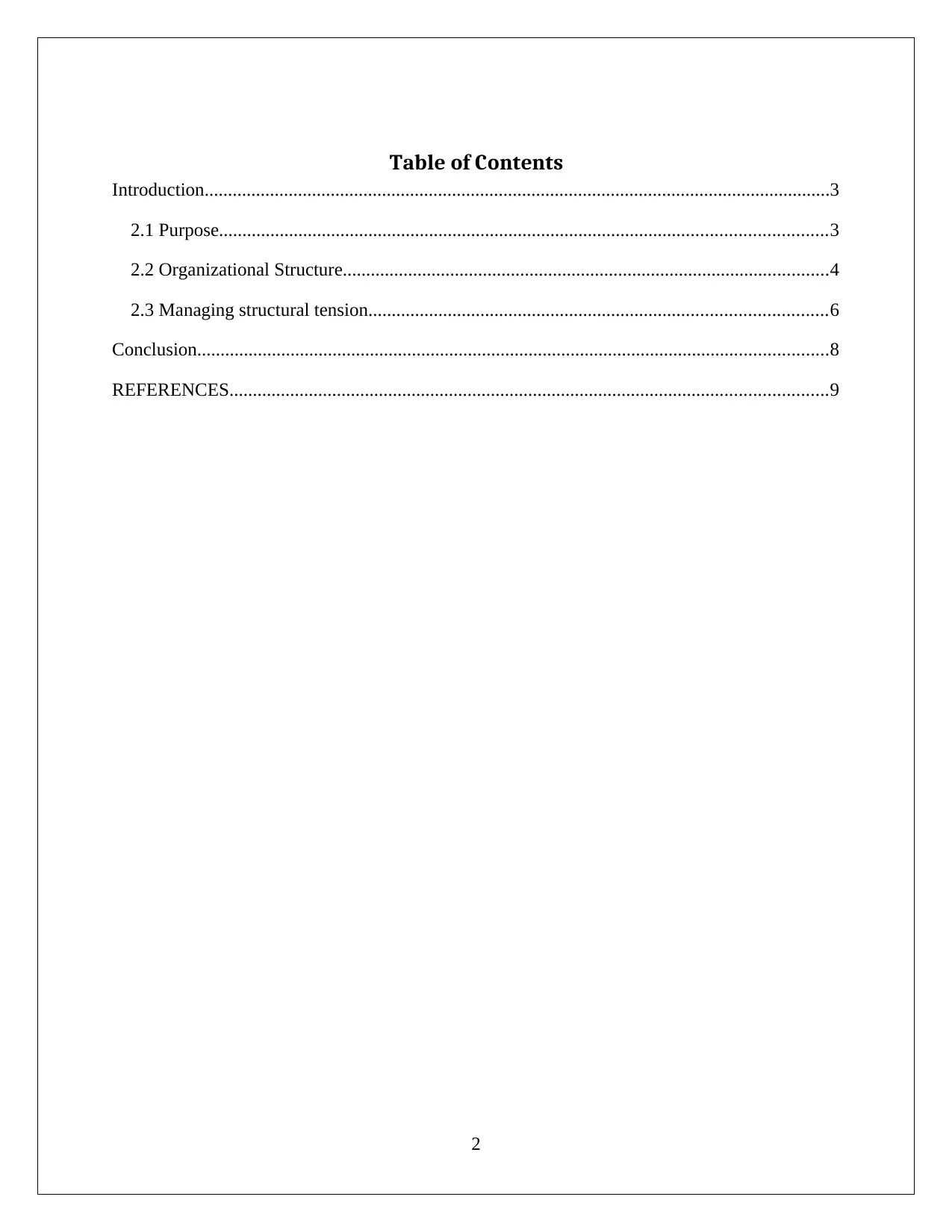
Table of Contents
Introduction......................................................................................................................................3
2.1 Purpose..................................................................................................................................3
2.2 Organizational Structure........................................................................................................4
2.3 Managing structural tension..................................................................................................6
Conclusion.......................................................................................................................................8
REFERENCES................................................................................................................................9
2
Introduction......................................................................................................................................3
2.1 Purpose..................................................................................................................................3
2.2 Organizational Structure........................................................................................................4
2.3 Managing structural tension..................................................................................................6
Conclusion.......................................................................................................................................8
REFERENCES................................................................................................................................9
2
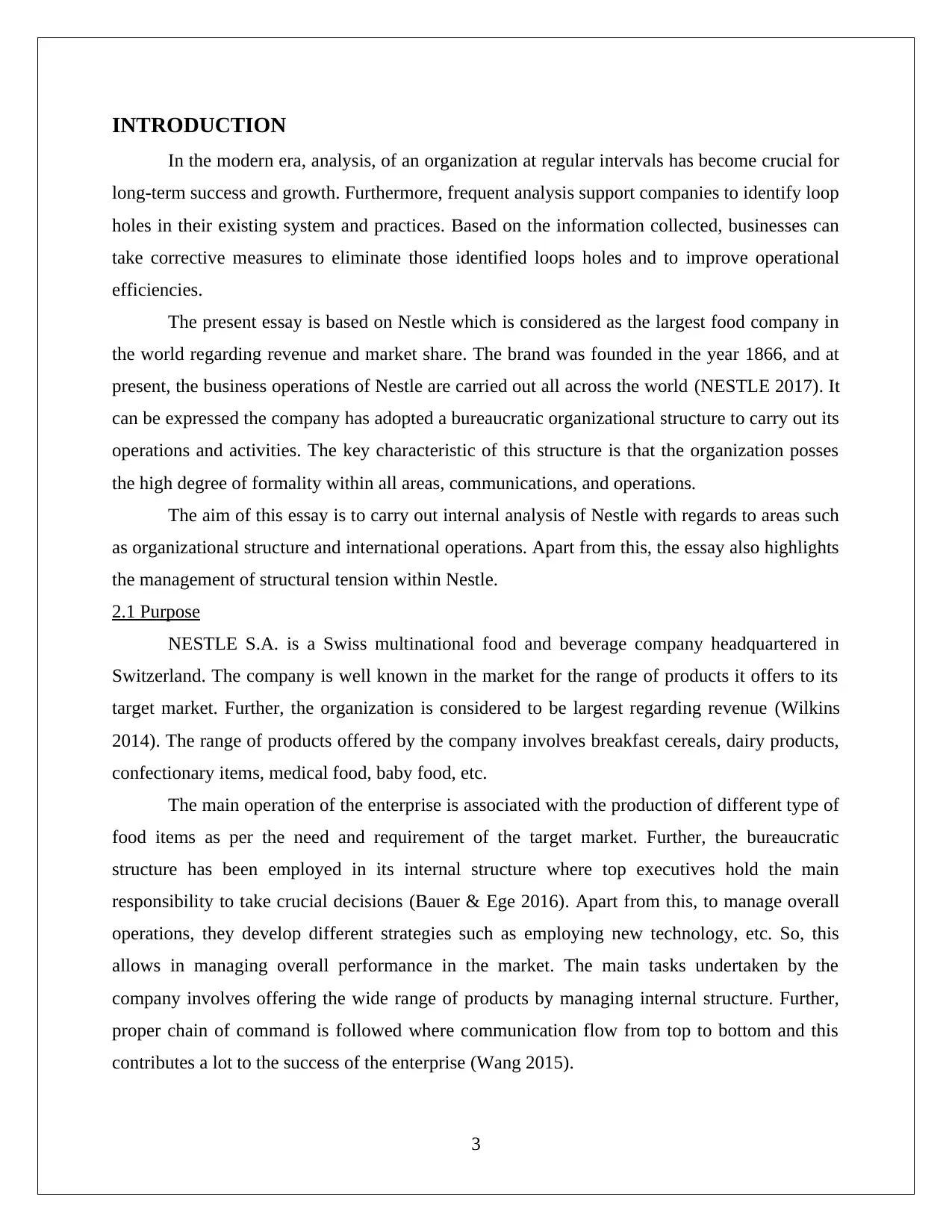
INTRODUCTION
In the modern era, analysis, of an organization at regular intervals has become crucial for
long-term success and growth. Furthermore, frequent analysis support companies to identify loop
holes in their existing system and practices. Based on the information collected, businesses can
take corrective measures to eliminate those identified loops holes and to improve operational
efficiencies.
The present essay is based on Nestle which is considered as the largest food company in
the world regarding revenue and market share. The brand was founded in the year 1866, and at
present, the business operations of Nestle are carried out all across the world (NESTLE 2017). It
can be expressed the company has adopted a bureaucratic organizational structure to carry out its
operations and activities. The key characteristic of this structure is that the organization posses
the high degree of formality within all areas, communications, and operations.
The aim of this essay is to carry out internal analysis of Nestle with regards to areas such
as organizational structure and international operations. Apart from this, the essay also highlights
the management of structural tension within Nestle.
2.1 Purpose
NESTLE S.A. is a Swiss multinational food and beverage company headquartered in
Switzerland. The company is well known in the market for the range of products it offers to its
target market. Further, the organization is considered to be largest regarding revenue (Wilkins
2014). The range of products offered by the company involves breakfast cereals, dairy products,
confectionary items, medical food, baby food, etc.
The main operation of the enterprise is associated with the production of different type of
food items as per the need and requirement of the target market. Further, the bureaucratic
structure has been employed in its internal structure where top executives hold the main
responsibility to take crucial decisions (Bauer & Ege 2016). Apart from this, to manage overall
operations, they develop different strategies such as employing new technology, etc. So, this
allows in managing overall performance in the market. The main tasks undertaken by the
company involves offering the wide range of products by managing internal structure. Further,
proper chain of command is followed where communication flow from top to bottom and this
contributes a lot to the success of the enterprise (Wang 2015).
3
In the modern era, analysis, of an organization at regular intervals has become crucial for
long-term success and growth. Furthermore, frequent analysis support companies to identify loop
holes in their existing system and practices. Based on the information collected, businesses can
take corrective measures to eliminate those identified loops holes and to improve operational
efficiencies.
The present essay is based on Nestle which is considered as the largest food company in
the world regarding revenue and market share. The brand was founded in the year 1866, and at
present, the business operations of Nestle are carried out all across the world (NESTLE 2017). It
can be expressed the company has adopted a bureaucratic organizational structure to carry out its
operations and activities. The key characteristic of this structure is that the organization posses
the high degree of formality within all areas, communications, and operations.
The aim of this essay is to carry out internal analysis of Nestle with regards to areas such
as organizational structure and international operations. Apart from this, the essay also highlights
the management of structural tension within Nestle.
2.1 Purpose
NESTLE S.A. is a Swiss multinational food and beverage company headquartered in
Switzerland. The company is well known in the market for the range of products it offers to its
target market. Further, the organization is considered to be largest regarding revenue (Wilkins
2014). The range of products offered by the company involves breakfast cereals, dairy products,
confectionary items, medical food, baby food, etc.
The main operation of the enterprise is associated with the production of different type of
food items as per the need and requirement of the target market. Further, the bureaucratic
structure has been employed in its internal structure where top executives hold the main
responsibility to take crucial decisions (Bauer & Ege 2016). Apart from this, to manage overall
operations, they develop different strategies such as employing new technology, etc. So, this
allows in managing overall performance in the market. The main tasks undertaken by the
company involves offering the wide range of products by managing internal structure. Further,
proper chain of command is followed where communication flow from top to bottom and this
contributes a lot to the success of the enterprise (Wang 2015).
3
⊘ This is a preview!⊘
Do you want full access?
Subscribe today to unlock all pages.

Trusted by 1+ million students worldwide
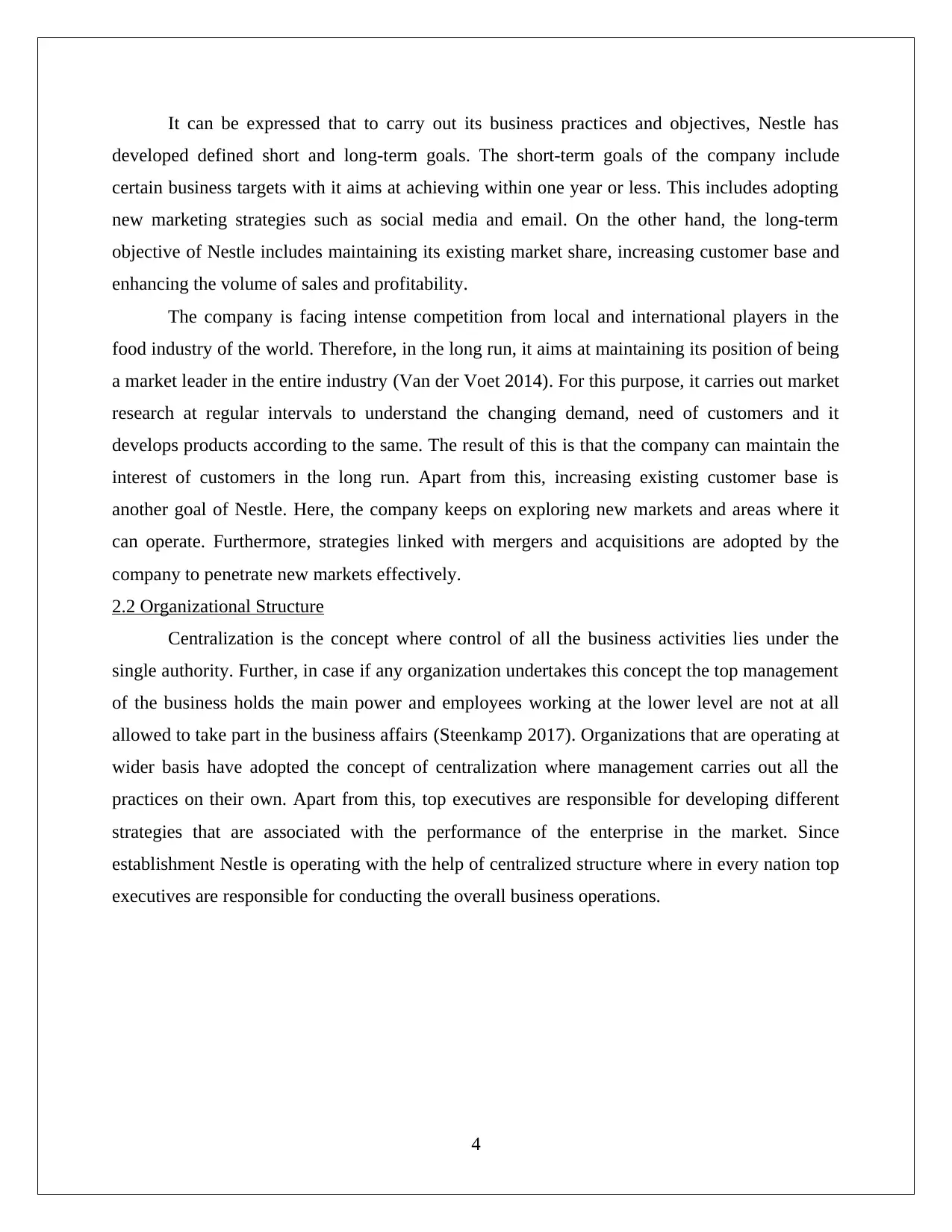
It can be expressed that to carry out its business practices and objectives, Nestle has
developed defined short and long-term goals. The short-term goals of the company include
certain business targets with it aims at achieving within one year or less. This includes adopting
new marketing strategies such as social media and email. On the other hand, the long-term
objective of Nestle includes maintaining its existing market share, increasing customer base and
enhancing the volume of sales and profitability.
The company is facing intense competition from local and international players in the
food industry of the world. Therefore, in the long run, it aims at maintaining its position of being
a market leader in the entire industry (Van der Voet 2014). For this purpose, it carries out market
research at regular intervals to understand the changing demand, need of customers and it
develops products according to the same. The result of this is that the company can maintain the
interest of customers in the long run. Apart from this, increasing existing customer base is
another goal of Nestle. Here, the company keeps on exploring new markets and areas where it
can operate. Furthermore, strategies linked with mergers and acquisitions are adopted by the
company to penetrate new markets effectively.
2.2 Organizational Structure
Centralization is the concept where control of all the business activities lies under the
single authority. Further, in case if any organization undertakes this concept the top management
of the business holds the main power and employees working at the lower level are not at all
allowed to take part in the business affairs (Steenkamp 2017). Organizations that are operating at
wider basis have adopted the concept of centralization where management carries out all the
practices on their own. Apart from this, top executives are responsible for developing different
strategies that are associated with the performance of the enterprise in the market. Since
establishment Nestle is operating with the help of centralized structure where in every nation top
executives are responsible for conducting the overall business operations.
4
developed defined short and long-term goals. The short-term goals of the company include
certain business targets with it aims at achieving within one year or less. This includes adopting
new marketing strategies such as social media and email. On the other hand, the long-term
objective of Nestle includes maintaining its existing market share, increasing customer base and
enhancing the volume of sales and profitability.
The company is facing intense competition from local and international players in the
food industry of the world. Therefore, in the long run, it aims at maintaining its position of being
a market leader in the entire industry (Van der Voet 2014). For this purpose, it carries out market
research at regular intervals to understand the changing demand, need of customers and it
develops products according to the same. The result of this is that the company can maintain the
interest of customers in the long run. Apart from this, increasing existing customer base is
another goal of Nestle. Here, the company keeps on exploring new markets and areas where it
can operate. Furthermore, strategies linked with mergers and acquisitions are adopted by the
company to penetrate new markets effectively.
2.2 Organizational Structure
Centralization is the concept where control of all the business activities lies under the
single authority. Further, in case if any organization undertakes this concept the top management
of the business holds the main power and employees working at the lower level are not at all
allowed to take part in the business affairs (Steenkamp 2017). Organizations that are operating at
wider basis have adopted the concept of centralization where management carries out all the
practices on their own. Apart from this, top executives are responsible for developing different
strategies that are associated with the performance of the enterprise in the market. Since
establishment Nestle is operating with the help of centralized structure where in every nation top
executives are responsible for conducting the overall business operations.
4
Paraphrase This Document
Need a fresh take? Get an instant paraphrase of this document with our AI Paraphraser
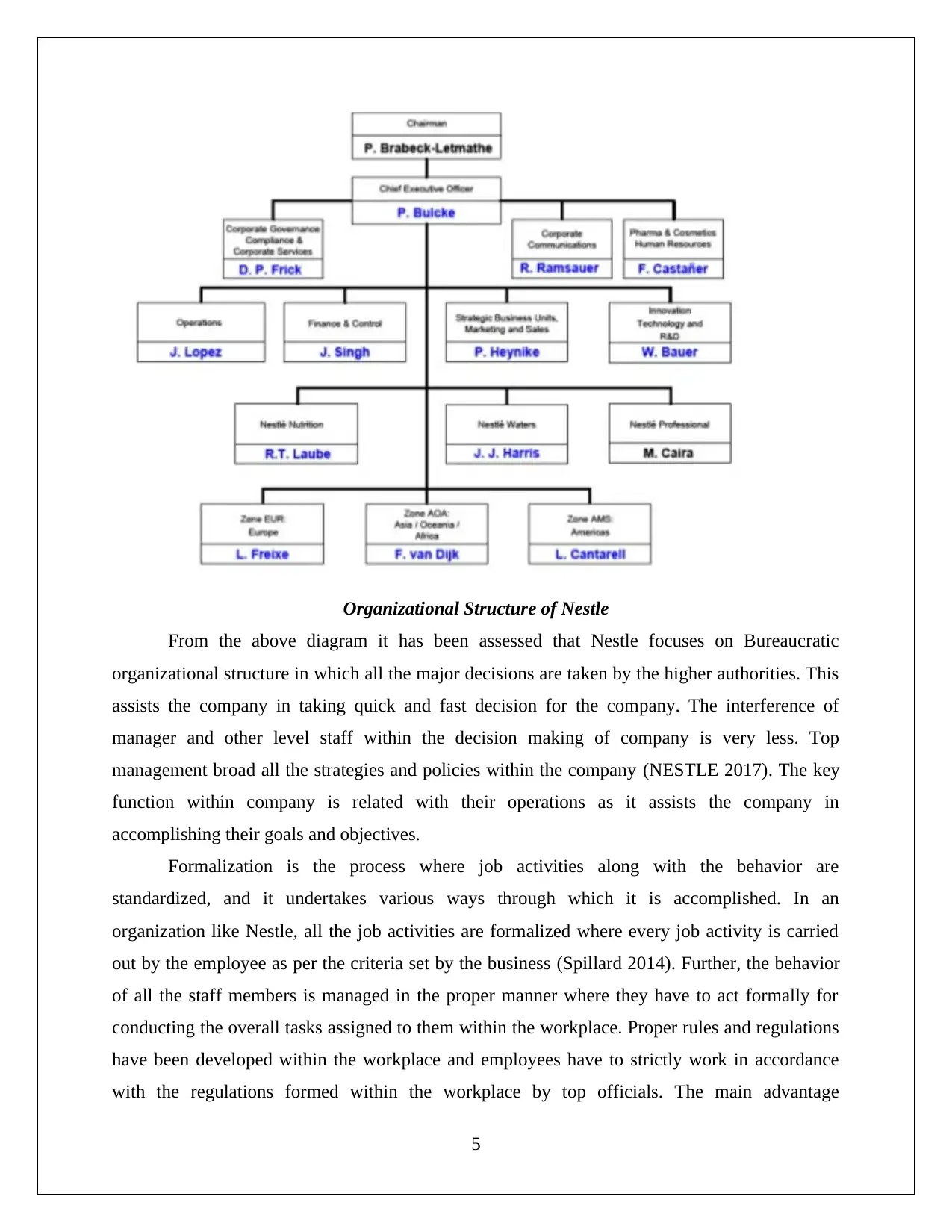
Organizational Structure of Nestle
From the above diagram it has been assessed that Nestle focuses on Bureaucratic
organizational structure in which all the major decisions are taken by the higher authorities. This
assists the company in taking quick and fast decision for the company. The interference of
manager and other level staff within the decision making of company is very less. Top
management broad all the strategies and policies within the company (NESTLE 2017). The key
function within company is related with their operations as it assists the company in
accomplishing their goals and objectives.
Formalization is the process where job activities along with the behavior are
standardized, and it undertakes various ways through which it is accomplished. In an
organization like Nestle, all the job activities are formalized where every job activity is carried
out by the employee as per the criteria set by the business (Spillard 2014). Further, the behavior
of all the staff members is managed in the proper manner where they have to act formally for
conducting the overall tasks assigned to them within the workplace. Proper rules and regulations
have been developed within the workplace and employees have to strictly work in accordance
with the regulations formed within the workplace by top officials. The main advantage
5
From the above diagram it has been assessed that Nestle focuses on Bureaucratic
organizational structure in which all the major decisions are taken by the higher authorities. This
assists the company in taking quick and fast decision for the company. The interference of
manager and other level staff within the decision making of company is very less. Top
management broad all the strategies and policies within the company (NESTLE 2017). The key
function within company is related with their operations as it assists the company in
accomplishing their goals and objectives.
Formalization is the process where job activities along with the behavior are
standardized, and it undertakes various ways through which it is accomplished. In an
organization like Nestle, all the job activities are formalized where every job activity is carried
out by the employee as per the criteria set by the business (Spillard 2014). Further, the behavior
of all the staff members is managed in the proper manner where they have to act formally for
conducting the overall tasks assigned to them within the workplace. Proper rules and regulations
have been developed within the workplace and employees have to strictly work in accordance
with the regulations formed within the workplace by top officials. The main advantage
5
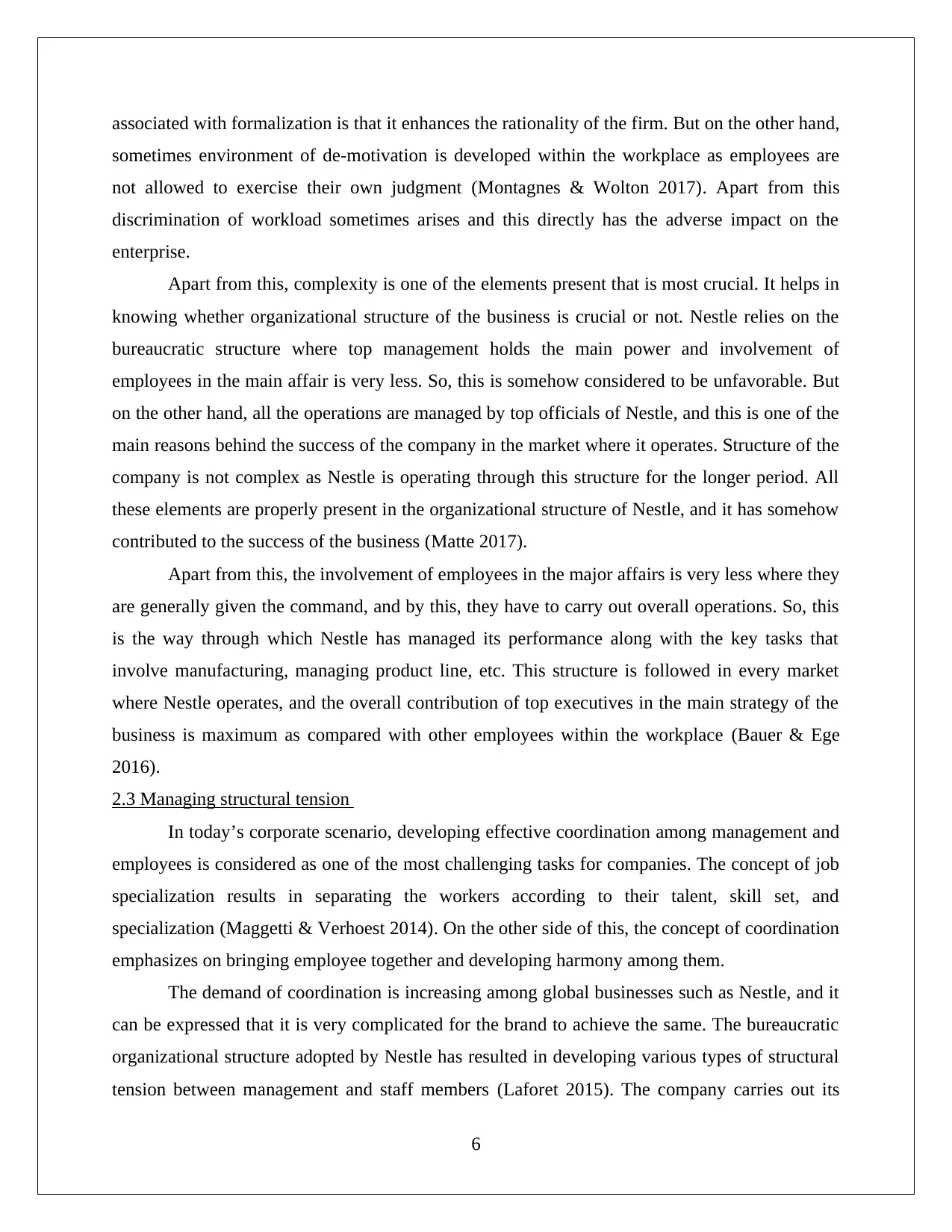
associated with formalization is that it enhances the rationality of the firm. But on the other hand,
sometimes environment of de-motivation is developed within the workplace as employees are
not allowed to exercise their own judgment (Montagnes & Wolton 2017). Apart from this
discrimination of workload sometimes arises and this directly has the adverse impact on the
enterprise.
Apart from this, complexity is one of the elements present that is most crucial. It helps in
knowing whether organizational structure of the business is crucial or not. Nestle relies on the
bureaucratic structure where top management holds the main power and involvement of
employees in the main affair is very less. So, this is somehow considered to be unfavorable. But
on the other hand, all the operations are managed by top officials of Nestle, and this is one of the
main reasons behind the success of the company in the market where it operates. Structure of the
company is not complex as Nestle is operating through this structure for the longer period. All
these elements are properly present in the organizational structure of Nestle, and it has somehow
contributed to the success of the business (Matte 2017).
Apart from this, the involvement of employees in the major affairs is very less where they
are generally given the command, and by this, they have to carry out overall operations. So, this
is the way through which Nestle has managed its performance along with the key tasks that
involve manufacturing, managing product line, etc. This structure is followed in every market
where Nestle operates, and the overall contribution of top executives in the main strategy of the
business is maximum as compared with other employees within the workplace (Bauer & Ege
2016).
2.3 Managing structural tension
In today’s corporate scenario, developing effective coordination among management and
employees is considered as one of the most challenging tasks for companies. The concept of job
specialization results in separating the workers according to their talent, skill set, and
specialization (Maggetti & Verhoest 2014). On the other side of this, the concept of coordination
emphasizes on bringing employee together and developing harmony among them.
The demand of coordination is increasing among global businesses such as Nestle, and it
can be expressed that it is very complicated for the brand to achieve the same. The bureaucratic
organizational structure adopted by Nestle has resulted in developing various types of structural
tension between management and staff members (Laforet 2015). The company carries out its
6
sometimes environment of de-motivation is developed within the workplace as employees are
not allowed to exercise their own judgment (Montagnes & Wolton 2017). Apart from this
discrimination of workload sometimes arises and this directly has the adverse impact on the
enterprise.
Apart from this, complexity is one of the elements present that is most crucial. It helps in
knowing whether organizational structure of the business is crucial or not. Nestle relies on the
bureaucratic structure where top management holds the main power and involvement of
employees in the main affair is very less. So, this is somehow considered to be unfavorable. But
on the other hand, all the operations are managed by top officials of Nestle, and this is one of the
main reasons behind the success of the company in the market where it operates. Structure of the
company is not complex as Nestle is operating through this structure for the longer period. All
these elements are properly present in the organizational structure of Nestle, and it has somehow
contributed to the success of the business (Matte 2017).
Apart from this, the involvement of employees in the major affairs is very less where they
are generally given the command, and by this, they have to carry out overall operations. So, this
is the way through which Nestle has managed its performance along with the key tasks that
involve manufacturing, managing product line, etc. This structure is followed in every market
where Nestle operates, and the overall contribution of top executives in the main strategy of the
business is maximum as compared with other employees within the workplace (Bauer & Ege
2016).
2.3 Managing structural tension
In today’s corporate scenario, developing effective coordination among management and
employees is considered as one of the most challenging tasks for companies. The concept of job
specialization results in separating the workers according to their talent, skill set, and
specialization (Maggetti & Verhoest 2014). On the other side of this, the concept of coordination
emphasizes on bringing employee together and developing harmony among them.
The demand of coordination is increasing among global businesses such as Nestle, and it
can be expressed that it is very complicated for the brand to achieve the same. The bureaucratic
organizational structure adopted by Nestle has resulted in developing various types of structural
tension between management and staff members (Laforet 2015). The company carries out its
6
⊘ This is a preview!⊘
Do you want full access?
Subscribe today to unlock all pages.

Trusted by 1+ million students worldwide
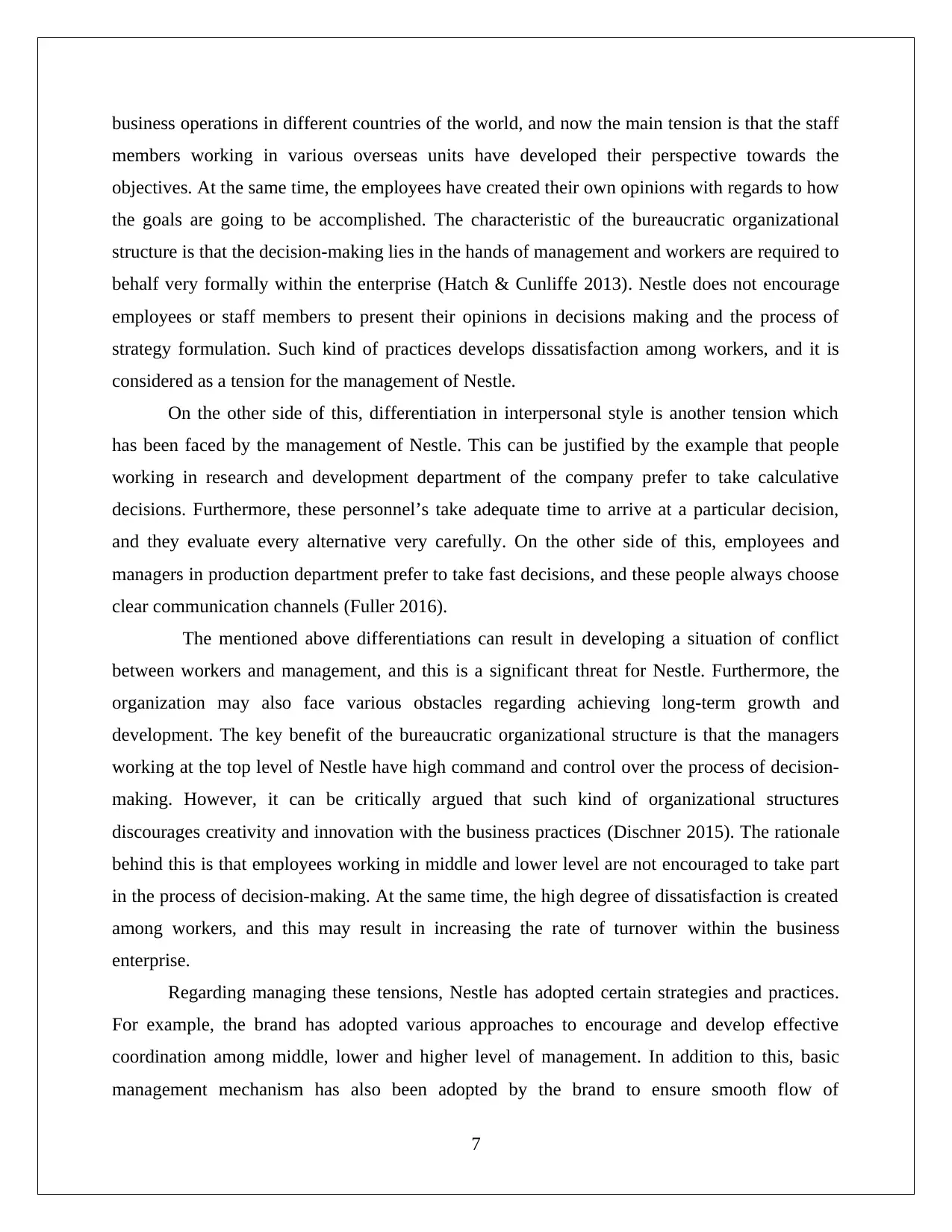
business operations in different countries of the world, and now the main tension is that the staff
members working in various overseas units have developed their perspective towards the
objectives. At the same time, the employees have created their own opinions with regards to how
the goals are going to be accomplished. The characteristic of the bureaucratic organizational
structure is that the decision-making lies in the hands of management and workers are required to
behalf very formally within the enterprise (Hatch & Cunliffe 2013). Nestle does not encourage
employees or staff members to present their opinions in decisions making and the process of
strategy formulation. Such kind of practices develops dissatisfaction among workers, and it is
considered as a tension for the management of Nestle.
On the other side of this, differentiation in interpersonal style is another tension which
has been faced by the management of Nestle. This can be justified by the example that people
working in research and development department of the company prefer to take calculative
decisions. Furthermore, these personnel’s take adequate time to arrive at a particular decision,
and they evaluate every alternative very carefully. On the other side of this, employees and
managers in production department prefer to take fast decisions, and these people always choose
clear communication channels (Fuller 2016).
The mentioned above differentiations can result in developing a situation of conflict
between workers and management, and this is a significant threat for Nestle. Furthermore, the
organization may also face various obstacles regarding achieving long-term growth and
development. The key benefit of the bureaucratic organizational structure is that the managers
working at the top level of Nestle have high command and control over the process of decision-
making. However, it can be critically argued that such kind of organizational structures
discourages creativity and innovation with the business practices (Dischner 2015). The rationale
behind this is that employees working in middle and lower level are not encouraged to take part
in the process of decision-making. At the same time, the high degree of dissatisfaction is created
among workers, and this may result in increasing the rate of turnover within the business
enterprise.
Regarding managing these tensions, Nestle has adopted certain strategies and practices.
For example, the brand has adopted various approaches to encourage and develop effective
coordination among middle, lower and higher level of management. In addition to this, basic
management mechanism has also been adopted by the brand to ensure smooth flow of
7
members working in various overseas units have developed their perspective towards the
objectives. At the same time, the employees have created their own opinions with regards to how
the goals are going to be accomplished. The characteristic of the bureaucratic organizational
structure is that the decision-making lies in the hands of management and workers are required to
behalf very formally within the enterprise (Hatch & Cunliffe 2013). Nestle does not encourage
employees or staff members to present their opinions in decisions making and the process of
strategy formulation. Such kind of practices develops dissatisfaction among workers, and it is
considered as a tension for the management of Nestle.
On the other side of this, differentiation in interpersonal style is another tension which
has been faced by the management of Nestle. This can be justified by the example that people
working in research and development department of the company prefer to take calculative
decisions. Furthermore, these personnel’s take adequate time to arrive at a particular decision,
and they evaluate every alternative very carefully. On the other side of this, employees and
managers in production department prefer to take fast decisions, and these people always choose
clear communication channels (Fuller 2016).
The mentioned above differentiations can result in developing a situation of conflict
between workers and management, and this is a significant threat for Nestle. Furthermore, the
organization may also face various obstacles regarding achieving long-term growth and
development. The key benefit of the bureaucratic organizational structure is that the managers
working at the top level of Nestle have high command and control over the process of decision-
making. However, it can be critically argued that such kind of organizational structures
discourages creativity and innovation with the business practices (Dischner 2015). The rationale
behind this is that employees working in middle and lower level are not encouraged to take part
in the process of decision-making. At the same time, the high degree of dissatisfaction is created
among workers, and this may result in increasing the rate of turnover within the business
enterprise.
Regarding managing these tensions, Nestle has adopted certain strategies and practices.
For example, the brand has adopted various approaches to encourage and develop effective
coordination among middle, lower and higher level of management. In addition to this, basic
management mechanism has also been adopted by the brand to ensure smooth flow of
7
Paraphrase This Document
Need a fresh take? Get an instant paraphrase of this document with our AI Paraphraser
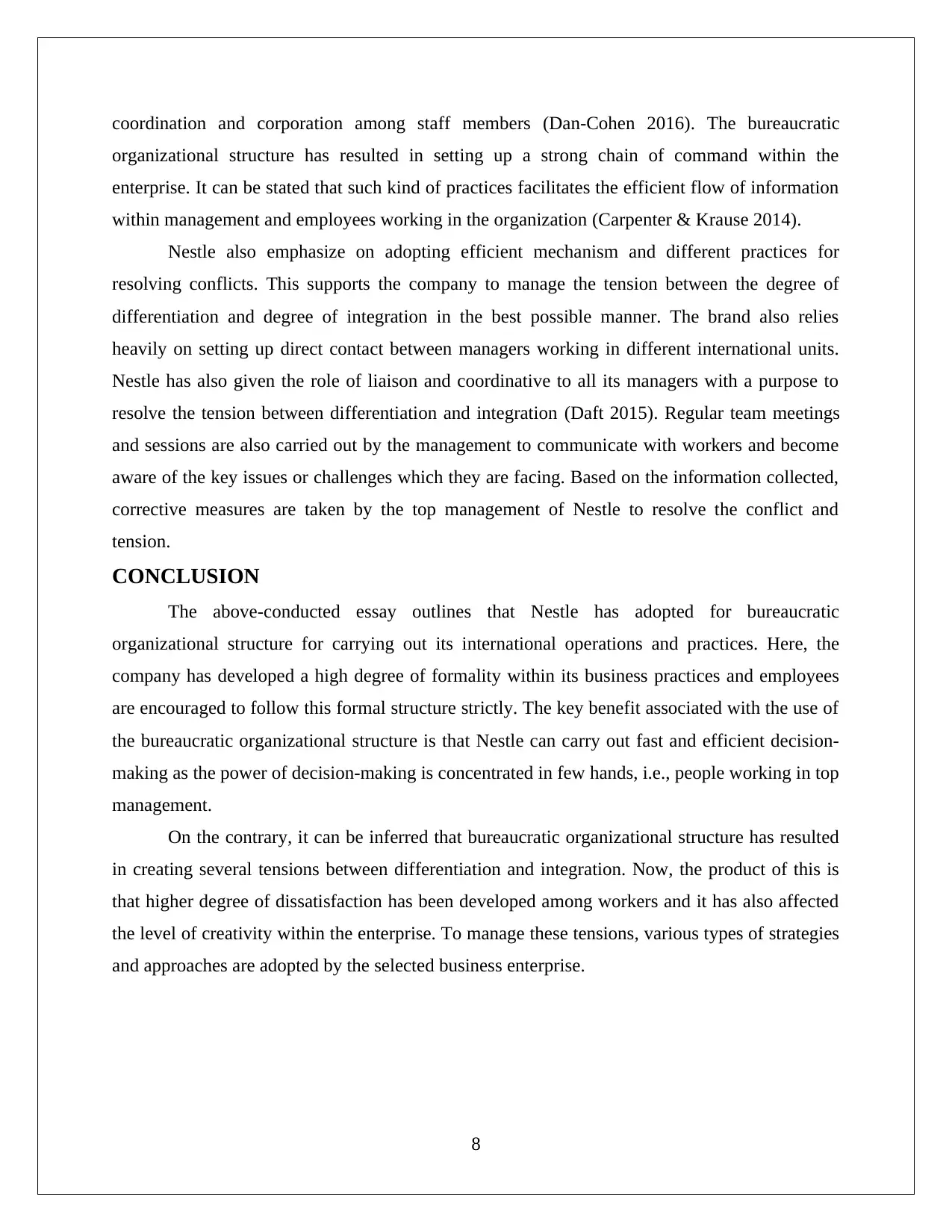
coordination and corporation among staff members (Dan-Cohen 2016). The bureaucratic
organizational structure has resulted in setting up a strong chain of command within the
enterprise. It can be stated that such kind of practices facilitates the efficient flow of information
within management and employees working in the organization (Carpenter & Krause 2014).
Nestle also emphasize on adopting efficient mechanism and different practices for
resolving conflicts. This supports the company to manage the tension between the degree of
differentiation and degree of integration in the best possible manner. The brand also relies
heavily on setting up direct contact between managers working in different international units.
Nestle has also given the role of liaison and coordinative to all its managers with a purpose to
resolve the tension between differentiation and integration (Daft 2015). Regular team meetings
and sessions are also carried out by the management to communicate with workers and become
aware of the key issues or challenges which they are facing. Based on the information collected,
corrective measures are taken by the top management of Nestle to resolve the conflict and
tension.
CONCLUSION
The above-conducted essay outlines that Nestle has adopted for bureaucratic
organizational structure for carrying out its international operations and practices. Here, the
company has developed a high degree of formality within its business practices and employees
are encouraged to follow this formal structure strictly. The key benefit associated with the use of
the bureaucratic organizational structure is that Nestle can carry out fast and efficient decision-
making as the power of decision-making is concentrated in few hands, i.e., people working in top
management.
On the contrary, it can be inferred that bureaucratic organizational structure has resulted
in creating several tensions between differentiation and integration. Now, the product of this is
that higher degree of dissatisfaction has been developed among workers and it has also affected
the level of creativity within the enterprise. To manage these tensions, various types of strategies
and approaches are adopted by the selected business enterprise.
8
organizational structure has resulted in setting up a strong chain of command within the
enterprise. It can be stated that such kind of practices facilitates the efficient flow of information
within management and employees working in the organization (Carpenter & Krause 2014).
Nestle also emphasize on adopting efficient mechanism and different practices for
resolving conflicts. This supports the company to manage the tension between the degree of
differentiation and degree of integration in the best possible manner. The brand also relies
heavily on setting up direct contact between managers working in different international units.
Nestle has also given the role of liaison and coordinative to all its managers with a purpose to
resolve the tension between differentiation and integration (Daft 2015). Regular team meetings
and sessions are also carried out by the management to communicate with workers and become
aware of the key issues or challenges which they are facing. Based on the information collected,
corrective measures are taken by the top management of Nestle to resolve the conflict and
tension.
CONCLUSION
The above-conducted essay outlines that Nestle has adopted for bureaucratic
organizational structure for carrying out its international operations and practices. Here, the
company has developed a high degree of formality within its business practices and employees
are encouraged to follow this formal structure strictly. The key benefit associated with the use of
the bureaucratic organizational structure is that Nestle can carry out fast and efficient decision-
making as the power of decision-making is concentrated in few hands, i.e., people working in top
management.
On the contrary, it can be inferred that bureaucratic organizational structure has resulted
in creating several tensions between differentiation and integration. Now, the product of this is
that higher degree of dissatisfaction has been developed among workers and it has also affected
the level of creativity within the enterprise. To manage these tensions, various types of strategies
and approaches are adopted by the selected business enterprise.
8
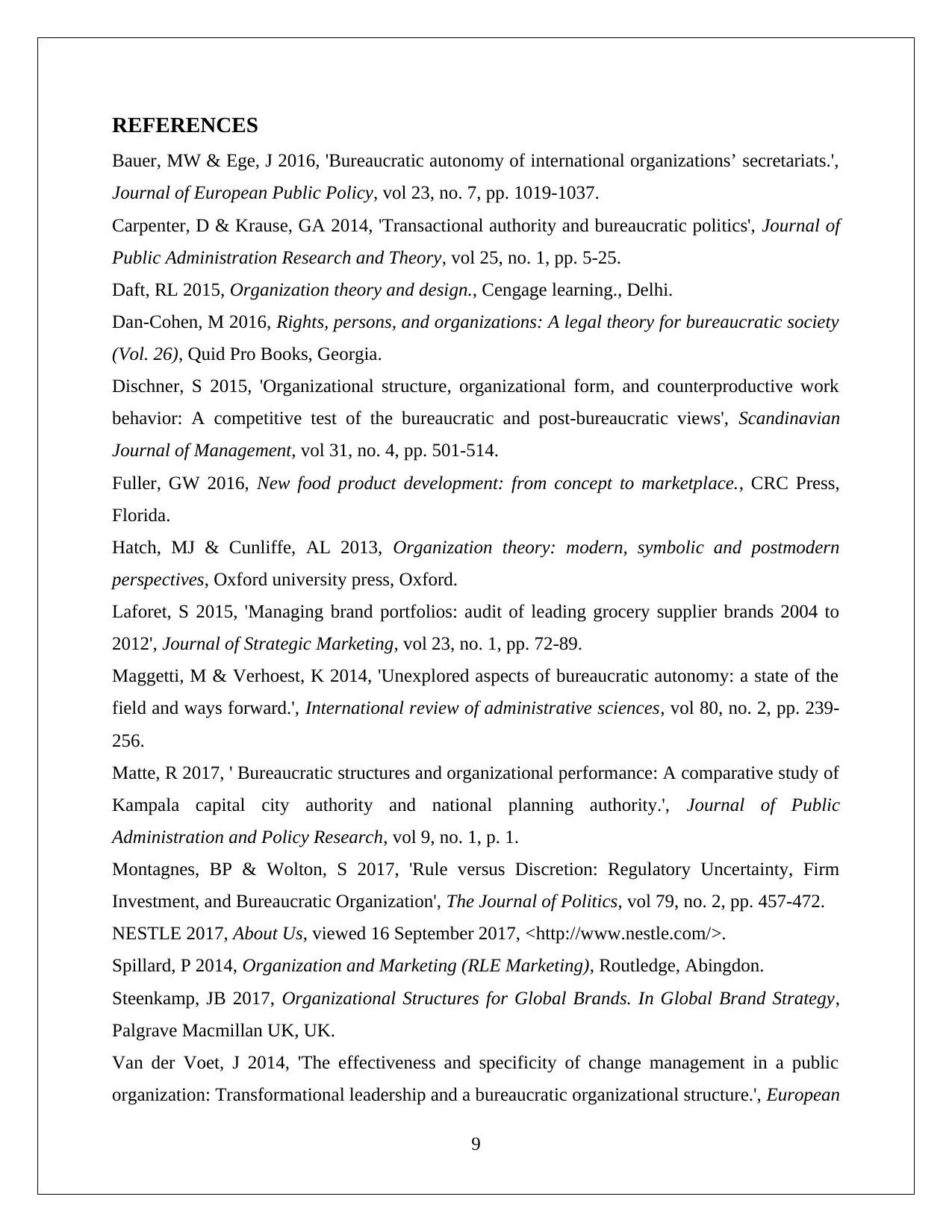
REFERENCES
Bauer, MW & Ege, J 2016, 'Bureaucratic autonomy of international organizations’ secretariats.',
Journal of European Public Policy, vol 23, no. 7, pp. 1019-1037.
Carpenter, D & Krause, GA 2014, 'Transactional authority and bureaucratic politics', Journal of
Public Administration Research and Theory, vol 25, no. 1, pp. 5-25.
Daft, RL 2015, Organization theory and design., Cengage learning., Delhi.
Dan-Cohen, M 2016, Rights, persons, and organizations: A legal theory for bureaucratic society
(Vol. 26), Quid Pro Books, Georgia.
Dischner, S 2015, 'Organizational structure, organizational form, and counterproductive work
behavior: A competitive test of the bureaucratic and post-bureaucratic views', Scandinavian
Journal of Management, vol 31, no. 4, pp. 501-514.
Fuller, GW 2016, New food product development: from concept to marketplace., CRC Press,
Florida.
Hatch, MJ & Cunliffe, AL 2013, Organization theory: modern, symbolic and postmodern
perspectives, Oxford university press, Oxford.
Laforet, S 2015, 'Managing brand portfolios: audit of leading grocery supplier brands 2004 to
2012', Journal of Strategic Marketing, vol 23, no. 1, pp. 72-89.
Maggetti, M & Verhoest, K 2014, 'Unexplored aspects of bureaucratic autonomy: a state of the
field and ways forward.', International review of administrative sciences, vol 80, no. 2, pp. 239-
256.
Matte, R 2017, ' Bureaucratic structures and organizational performance: A comparative study of
Kampala capital city authority and national planning authority.', Journal of Public
Administration and Policy Research, vol 9, no. 1, p. 1.
Montagnes, BP & Wolton, S 2017, 'Rule versus Discretion: Regulatory Uncertainty, Firm
Investment, and Bureaucratic Organization', The Journal of Politics, vol 79, no. 2, pp. 457-472.
NESTLE 2017, About Us, viewed 16 September 2017, <http://www.nestle.com/>.
Spillard, P 2014, Organization and Marketing (RLE Marketing), Routledge, Abingdon.
Steenkamp, JB 2017, Organizational Structures for Global Brands. In Global Brand Strategy,
Palgrave Macmillan UK, UK.
Van der Voet, J 2014, 'The effectiveness and specificity of change management in a public
organization: Transformational leadership and a bureaucratic organizational structure.', European
9
Bauer, MW & Ege, J 2016, 'Bureaucratic autonomy of international organizations’ secretariats.',
Journal of European Public Policy, vol 23, no. 7, pp. 1019-1037.
Carpenter, D & Krause, GA 2014, 'Transactional authority and bureaucratic politics', Journal of
Public Administration Research and Theory, vol 25, no. 1, pp. 5-25.
Daft, RL 2015, Organization theory and design., Cengage learning., Delhi.
Dan-Cohen, M 2016, Rights, persons, and organizations: A legal theory for bureaucratic society
(Vol. 26), Quid Pro Books, Georgia.
Dischner, S 2015, 'Organizational structure, organizational form, and counterproductive work
behavior: A competitive test of the bureaucratic and post-bureaucratic views', Scandinavian
Journal of Management, vol 31, no. 4, pp. 501-514.
Fuller, GW 2016, New food product development: from concept to marketplace., CRC Press,
Florida.
Hatch, MJ & Cunliffe, AL 2013, Organization theory: modern, symbolic and postmodern
perspectives, Oxford university press, Oxford.
Laforet, S 2015, 'Managing brand portfolios: audit of leading grocery supplier brands 2004 to
2012', Journal of Strategic Marketing, vol 23, no. 1, pp. 72-89.
Maggetti, M & Verhoest, K 2014, 'Unexplored aspects of bureaucratic autonomy: a state of the
field and ways forward.', International review of administrative sciences, vol 80, no. 2, pp. 239-
256.
Matte, R 2017, ' Bureaucratic structures and organizational performance: A comparative study of
Kampala capital city authority and national planning authority.', Journal of Public
Administration and Policy Research, vol 9, no. 1, p. 1.
Montagnes, BP & Wolton, S 2017, 'Rule versus Discretion: Regulatory Uncertainty, Firm
Investment, and Bureaucratic Organization', The Journal of Politics, vol 79, no. 2, pp. 457-472.
NESTLE 2017, About Us, viewed 16 September 2017, <http://www.nestle.com/>.
Spillard, P 2014, Organization and Marketing (RLE Marketing), Routledge, Abingdon.
Steenkamp, JB 2017, Organizational Structures for Global Brands. In Global Brand Strategy,
Palgrave Macmillan UK, UK.
Van der Voet, J 2014, 'The effectiveness and specificity of change management in a public
organization: Transformational leadership and a bureaucratic organizational structure.', European
9
⊘ This is a preview!⊘
Do you want full access?
Subscribe today to unlock all pages.

Trusted by 1+ million students worldwide
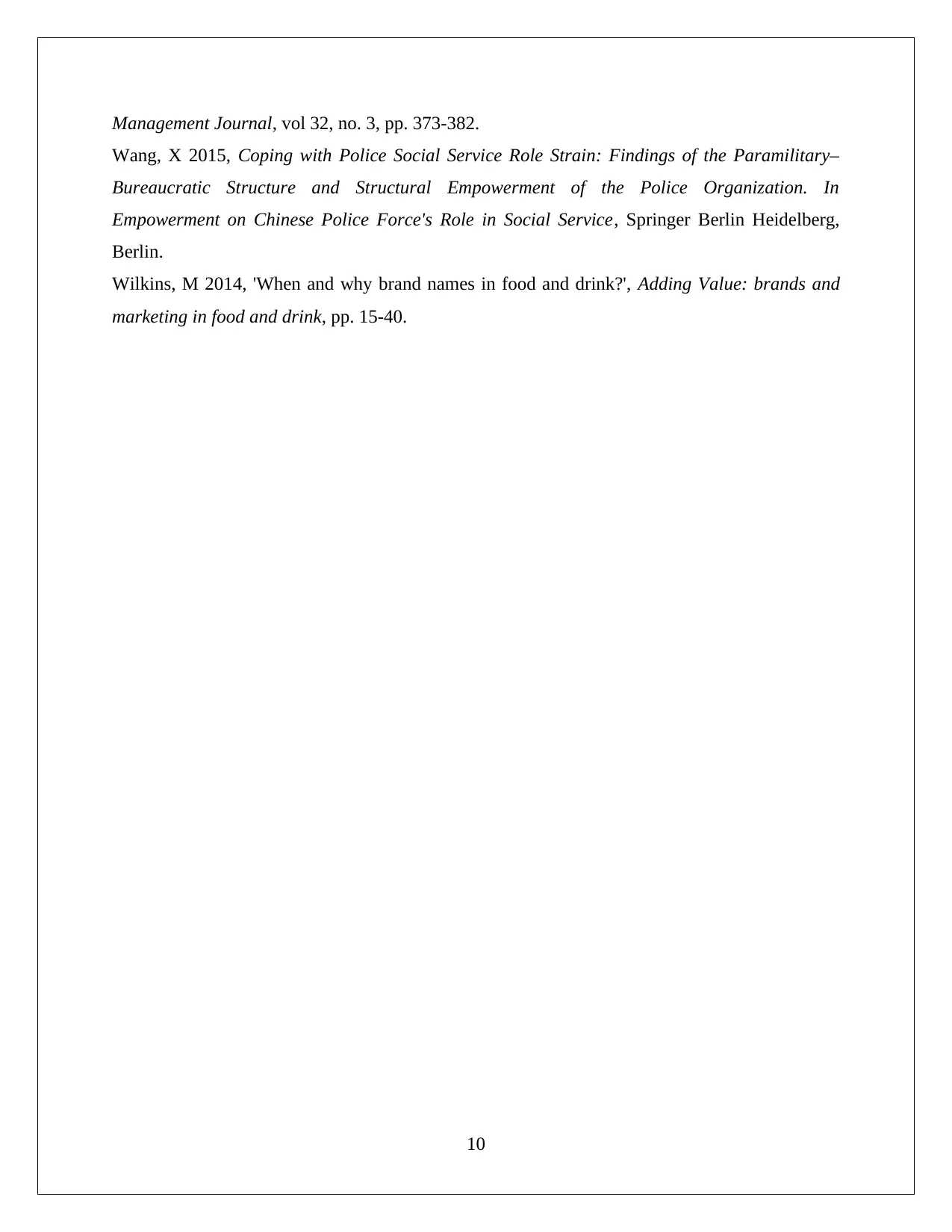
Management Journal, vol 32, no. 3, pp. 373-382.
Wang, X 2015, Coping with Police Social Service Role Strain: Findings of the Paramilitary–
Bureaucratic Structure and Structural Empowerment of the Police Organization. In
Empowerment on Chinese Police Force's Role in Social Service, Springer Berlin Heidelberg,
Berlin.
Wilkins, M 2014, 'When and why brand names in food and drink?', Adding Value: brands and
marketing in food and drink, pp. 15-40.
10
Wang, X 2015, Coping with Police Social Service Role Strain: Findings of the Paramilitary–
Bureaucratic Structure and Structural Empowerment of the Police Organization. In
Empowerment on Chinese Police Force's Role in Social Service, Springer Berlin Heidelberg,
Berlin.
Wilkins, M 2014, 'When and why brand names in food and drink?', Adding Value: brands and
marketing in food and drink, pp. 15-40.
10
1 out of 10
Related Documents
Your All-in-One AI-Powered Toolkit for Academic Success.
+13062052269
info@desklib.com
Available 24*7 on WhatsApp / Email
![[object Object]](/_next/static/media/star-bottom.7253800d.svg)
Unlock your academic potential
Copyright © 2020–2025 A2Z Services. All Rights Reserved. Developed and managed by ZUCOL.




